Local News
Gray Academy has gone eight months with not one single case of COVID
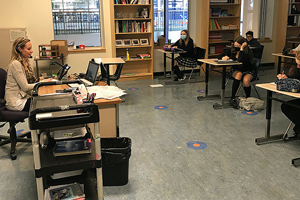
over 675 cases in other Manitoba schools
By BERNIE BELLAN
While Manitobans can rightfully be said to be in a state of shock over how this province has gone from having one of the best records anywhere at keeping COVID at bay to now having one of the worst in Canada, the focus has very much been on the tragic situations in many personal care homes.
Yet, the situation in schools for the most part is one where there has also been a steady number of COVID cases either having been reported or suspected. Since all available evidence to this point, however, is that COVID simply does not affect young people to the same degree that it does the elderly (among whom I can rightfully count myself), I think it’s fair to say that not much attention has been paid to what’s been happening in schools in this province.
According to the CBC Manitoba website, however, “Manitoba had recorded 675 cases of COVID-19 in schools as of Nov. 17. A total of 513 of those were students and 162 were staff members.
The CBC website goes on to note that “The province has posted dozens of possible exposures at schools across Manitoba on its website – including more than 150 exposures at schools in the Winnipeg health region since Sept. 25.”
Since ours is a newspaper serving the Jewish community I thought it appropriate to take a look at what’s been happening in the only fully JK-12 Jewish day school in the province: Gray Academy.
Luckily, it is fair to report in the case of that school that “no news is good news.”
Since the first lockdown began on March 14 I’ve had occasion to speak with Gray Academy Head of School and CEO Lori Binder twice before: In our May 27 issue, when we took a detailed look at how Gray Academy had made the successful transition to teaching online through what it called its “Gray Away” online program; and in our Sept. 2 issue, when we took a look at plans that were put in place to welcome back students under the highly restrictive protocols that the province had established for all schools in Manitoba.
Now, with almost three full months having gone by since the start of the new school year, I thought it appropriate to speak with Lori again to get her assessment of how things have gone at Gray Academy thus far. Joining in the phone conversation was Andrea Ritter, Director, Marketing and Communications.
No cases of COVID at Gray Academy thus far
I began by asking whether “there have been any incidents of COVID at the school?”
Lori answered: “Thank G-d no, there have not. We’ve been healthy every day.”
I asked: “Are any of your students now taking their schooling online?”
Lori: “Let me give you a general overview. We are fully open. We are able to have our students with two meters distance all the way up to Grade 12. We made that change when schools moved to orange and that was already in place in the elementary. We were able to spread out more, so that for example, our Mac lab that was used for the film class, we’re now using it for other classes and we’ve moved a grade to another corner of the school.
“We are open five days a week for every one of our students unless they fail our health screening.”
Lori went on to explain that if, for any reason, a student is unable to attend classes in person beginning with Grade 5, they are able to “access classes online. They are able to login to ‘Google classroom’ and they are able to participate.” As well, students are beginning to learn to use Google Classroom independently in Grades 3 & 4.
But, she noted, “we don’t have a remote choice option – meaning a student is just choosing to be remote – but if they’re not in the building and they’re still well enough to learn, they can access the classroom from home.”
In terms of how many students have actually been absent from school on any given day, Lori said that the average attendance has been “approximately 90% on a daily basis.”
Enrolment has remained up
I asked how enrolment this year compares with last year?
“Last year it was 494,” Lori answered. “This year it’s 484.”
She noted, however, that the school’s “retention percentage” (meaning “how many students didn’t graduate and were eligible to return”) is at “93%”.
Lori added that, “We only had two families that, before school started, chose to home school.”
In terms of how many new students are at Gray Academy this year, Lori said there are 60 new students (who could be in grades as early as Junior Kindergarten). While there were 80 new students in the 2019-20 academic year, the lower figure, Lori explained, is largely explained by the fact that, “of those 60 new students we’re seeing more local as we’ve seen fewer families arrive from outside of Canada.”
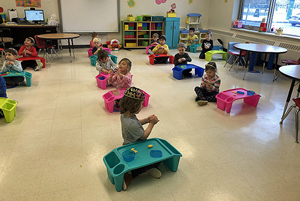
Andrea Ritter noted that “this has been an unusual year when we’ve had to turn people away when we filled our rooms. We had to maintain that distancing between students in rooms – which meant we had to limit our capacity in certain classrooms. We had to cut off our registration for JK and K for sure.”
Lori gave as an example an inquiry the school had from someone wanting to enroll their child in Grade 4. “We had no more room,” she explained, “ so we had to tell them their child was on a wait list.”
I asked whether there was a breakdown of class size by grade. Lori said they had figures for high school and elementary. “Last year our high school (Grades 7-12) was 211 and this year it’s 218. Our elementary (JK-Grade 6), last year was 283; this year it went down a little to 266.”
All staff returned this year – and have remained
At that point in the conversation I said I wanted to turn attention to the staff of the school. I asked whether everyone had returned?
Lori answered: “Our staff is all here. No one chose not to continue working because of COVID and we’ve welcomed some new staff. They’ve been amazing. Our staff are so committed to who we are as a school community, committed to being able to provide our students purpose, a place to be, and a community where they’re known and cared for by the teachers.
“If you were to say to us, before we knew what COVID was, that we’re going to run a school, and we’re going to keep changing, and as a teacher you’re going to have to start moving around from class to class – and you’re going to have some kids in one classroom and some in another, and you’re going to always be on the alert for changes from the province – our staff have been really incredible.
“From my educational lens, what I see is that our kids really want to be in school; they want to be somewhere. They don’t want to be in isolation. We’re all social beings, teenagers especially – they crave being with others, being in community.
“We’re doing things we’ve never done before. Bernie, if you ever want to come and watch our pick-up and drop-off – it’s a science we’ve created. We’ve got this orderly fashion how kids get out of their cars so we can limit gatherings and have kids go through doorways one at a time. We’re just so grateful for the positivity of our staff and the partnership with our families.”
Could Gray Academy remain open if other schools are forced to shut their doors?
I wondered though about something that doesn’t get discussed much within general conversation. The province has been releasing data about which geographic areas have been hardest hit by COVID (also which schools) and it has been quite evident that the pandemic has taken a disproportionate toll on socioeconomic groups that are more disadvantaged. Now, with talk of a possible even more drastic shutdown that would encompass schools this time – but with Gray Academy, among other schools, having fared quite well in terms of avoiding any incidents of COVID, I asked whether the possibility that some schools might be allowed to remain open while others would have to close had ever been brought up in discussions with representatives from the Department of Education?
Lori responded that “What I can share, and has not changed ever since the summer, is they’ve always spoken about what would make schools move into the red pandemic response level. We know that one reason is transmission in a school that is specific to that school. We saw that happen with one of the first schools in the River East School Division (John Pritchard) where a cohort was moved out – and that was specific to that school.
“That same basic message is what we’re still hearing: ‘There would be a change to a school if there’s evidence of transmission within a school….We have to be prepared for anything that might happen., but my belief is there won’t be a decision made based on anything other than what’s happening in specific schools.”
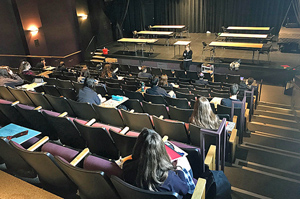
Some classrooms have been able to accommodate fairly large numbers of students
I wondered what the maximum class size is now that each student is required to maintain a distance of 2 metres all around?
“In elementary, believe it or not,” Lori responded, “we’ve taken out furniture; we’ve removed bookshelves that were screwed to the walls for decades – in order to make more room – it would be around 18 or 19; and in high school, we’ve been using some of the larger spaces for classrooms – like the Mac lab – where we can get around 20 or 21 students. Right now, because we’ve always had the availability of the Berney Theatre, there is a group in the foyer and a group utilizing the theatre so that we can really give kids the space.”
“That would mean you’re having university style lectures in the theatre itself,” I suggested.
Further, because there are windows in the foyer the school is able to open the blinds and get some natural light into that space, Lori explained.
Andrea added that students who are taking classes in the theatre have become quite resourceful in adapting to the theatre format. “It’s energized the kids. As soon as they went to the Berney (Theatre) they all started coming up with ideas, like ‘How can I create a lap desk for myself?’ because it’s hard to hold your Chromebook on your lap while you’re taking notes.”
Lori also noted that, until the province ordered the entire city into code red, Shmoozers had been providing hot lunches for kids – brought to them in their rooms. “We’re trying to keep our hot lunch program going – at least for this month,” she noted, “with food from other kosher catering. We don’t have volunteers coming in right now, so we (the staff) are doing that.”
Talking about the staff and lunches, I asked whether staff are still eating their lunches in the Kaufman-Silverberg Library?
“Our high school staff are,” Lori said, “but we still have our staff room. It’s just limited by how many people can be in there at once. There’s enough space for 12. There are other places for staff to go.”
Morale has remained high – and students have shown amazing resillience
I asked whether there are any assessments of morale that are taken on any sort of systematic basis or is it all based on anecdotal evidence? After all, I suggested to Lori, “you’re giving me what would be considered a pretty upbeat report.”
Andrea Ritter said she’d like to jump in at that point, “speaking both as a professional and as a mom” of two students at Gray Academy.
“I was home last year with both my kids (when all schools closed from March on). My older one (who’s 15 – in Grade 10) was fine; she’s very independent, she did her own thing. She didn’t mind being online.
“The little one (who’s 9 – in Grade 4),” Andrea continued – “it was really hard for her, especially when we weren’t having a full day of classes, when we would just meet (online) here and there. She really had a tough time emotionally.
“When we switched to full-on Gray Away in April, and she was with her classmates in a structured environment every day, it made an enormous difference for her.
“But for me, seeing the children here on site, I am amazed how they’ve taken everything in stride. Sure, every time there’s a change, they complain like crazy for a day or two, then they just move along and carry on with their day.
“Some of the high school kids especially have gotten a little bit innovative in providing entertainment for themselves. They can’t go anywhere, they’re not allowed to leave Campus – and that’s one of the ways we’re trying to keep control on transmission. (Ed. note: Compare that with kids from Grant Park who had been flocking both to the nearby McDonald’s and Grant Park Shopping Centre.)
Andrea continued: “They’re creating some new clubs at lunch, they’re hanging out in different spaces – but the little ones, in particular, interact when they’re outside – in masks, at recess – it doesn’t matter – it doesn’t make a difference to them. They take it completely in stride. I hear them all day. My window faces the playground. They play like they always have.
“I’ve certainly seen discussions online from different points of view – how terrible it is to have kids in masks all day. Fortunately for us we have the space. Our kids (up to Grade 4 and up) can be out of masks and have a mask break so long as they’re at their desks and when they have to put their masks on for recess (grades 3-6) or for gym (grade 4 and up) – they’re just taking it in stride.”
Lori chimed in: “Every day that we can have this building open and our children are healthy, it means that our kids are getting what they need to develop mentally, developmentally – and the resiliency – I am also proud of our students’ resiliency.… I remember the first day that kids were getting dropped off, who would have thought that three and four-year-olds would be hopping out of the car and walking themselves (with staff) to the early years’ wings door? Usually it would have been the parents holding their hands, walking them to the door of their classroom.
“We’re here to give kids a place to be and, from a mental health and wellness perspective, that’s what contributes to being able to learn.
“So, I’m not saying it’s not hard; it is hard and I’d like to see those vaccines come to light sooner rather than later, but as long as we can keep these kids feeling well, we’re upbeat.”
Local News
Community leader Sheldon Zamick role model of perseverance despite life’s vicissitudes

By MYRON LOVE For Sheldon Zamick, life is a marathon, not a sprint – and there is always more to learn. In a life marked by struggles, he has overcome adversity and written a story of success both in business and community leadership.
Over the years, he has given of his time and experience to a great variety of charitable organization – including the Jewish Federation, the CJA, the JNF, Canadian Associates of Ben-Gurion University of the Negev, the Canadian Magen David Adom, the Shaarey Zedek Synagogue (he is currently the Board’s finance chair), the Canadian Museum for Human Rights, Mount Carmel Clinic, the Variety Club, Muscular Dystrophy, Habitat for Humanity, Siloam Mission, and the Canadian Institute for the Blind. The most recent charitable organization that has benefited from his leadership has been the Lake Winnipeg Research Consortium.
He took on his most recent challenge as executive director of the Lake Winnipeg Research Consortium last year after stepping away from a 40-year career in real estate sales. “This is a really big responsibility,” he says of taking the helm of the LWRC.
As noted on the LWRC webpage, the organization was founded in 1998 “to facilitate scientific research on Lake Winnipeg following evidence of water quality deterioration related to the 1997 Red River ‘Flood of the Century’. The LWRC was incorporated in Manitoba in 2001 and received charitable status in 2008”.
“Our organization does vital research in regard to Lake Winnipeg,” Zamick points out. “Our 328-ton, 110-foot-long ship, the MV Namao – which celebrated its 50th birthday this past August (during which over 1200 supporters toured the boat) in Gimli – is out regularly in the spring, summer and fall on Lake Winnipeg taking water samples. We provide the research platform for scientists to conduct research with regard to climate change and the state of the lake and fish population. We offer science education year round, group tours and summer camp programs for kids.”
He adds that the consortium works closely with many stakeholders, including the Universities of Manitoba and Winnipeg, and receives funding from the Winnipeg Foundation, the Canada Water Agency, Manitoba Hydro, the Manitoba Government, the City of Winnipeg, the town of Gimli, other municipalities and many individual donors.
“It has been great getting the opportunity to meet with various government officials, research partners and donors,” he says.
Sheldon Zamick is a role model demonstrating that an individual growing up in humble surroundings and having to deal with adverse circumstances can succeed in life. He recalls how he had to go to work early in life – at the age of 12 – to help support his family. “We moved around a lot when I was growing up in the North End because my parents could never afford to buy their own home,” he recounts. “That is what drew me to a career in real estate.”
His first job, he says, was peeling potatoes in the basement at Kelekis (a long gone North End Winnipeg restaurant which those of us of a certain age still fondly remember). “I had to learn at an early age to be self-sufficient,” he notes.
In his university days, he worked part time as a corrrections officer – taking as many shifts he could get – at the Winnipeg Remand Centre.
He also demonstrated his leadership capacity at an early age. At 17, he served as president of the USY chapter at the former Rosh Pina Synagogue (even though his parents couldn’t afford to be members of the shul).
After graduating from the University of Manitoba with degrees in Economics and Psychology, he founded TV Facts Magazine, a free weekly TV and shopping guide which some readers may remember. “TV Facts was part of an international chain of publications,” he recounts. “I had to travel to New York to learn how to run a magazine. At our peak, we were putting out 50,000 copies a week – which were available in over 500 locations.”
It was in 1985 that Zamick pursued his interest in becoming a realtor – a profession in which he excelled. Over 40 years as a realtor, he received numerous sales awards, also recognition for his leadership role in his profession and his numerous contributions to the wider community. In the former field, he served for five years as a member of the Winnipeg Real Estate Board, including a term as treasurer and chairing the Government Relations committee.
In 2013-14, he was elected as a director of the 120,000-member Canadian Real Estate Association.
Zamick was recruited into volunteering in the Jewish community, he notes, in the mid-1980s by Laurie Goldberg and the late Larry Rosenberg, who were co-chairs of the Federation’s Young Adult Division. Sheldon subsequently served as co-chair –with Sid Halpern – of the 1987-88 Combined Jewish Appeal’s New Gifts Division.
“We were responsible for contacting members of the community who hadn’t given for a long time,” he explains. “We were really successful in persuading many of them to contribute to the campaign and (by extension) the community.”
That year, he and current outgoing Federation president Paula Parks were nominated to receive our community’s Young Leadership award. Zamick was presented with the Harry Silverberg Young Leader of Distinction Award by Nora Kaufman, the late Harry Silverberg’s daughter.
He later served as the CJA’s campaign director from 1989 to 1992. “During the 1989-90 campaign – that included Operation Exodus (aimed to help Jews leave the dying Soviet Union) – we raised an extra $2 million- bringing in a total of $6-million that year.”
In 1992, Zamick was afflicted with a condition that might have derailed a lesser individual. He was diagnosed with Retinitis Pigmentosa, a condition that left him legally blind. The ever resilient Zamick however took the diagnosis in stride. In 2022, he told an online publication called “Slideshare” that, after the diagnosis, he chose to be thankful for what he had rather than focus on what he had lost.
He added that while legally blind, he still has some sight in certain lighting. “It is a unique way to live,” he told Slideshare, “but you have to adapt to it and I haven’t let it stop me.”
He has been helped immensely by his longtime, supportive wife, Florence.
Typically, following his diagnosis, he threw himself into volunteering with the Canadian National Institute of the Blind. He served on the board of the CNIB for 16 years and was a leader in raising the funds one year – when the CNIB was facing government cutbacks.
Zamick is planning to retire from his current position at the end of this month. He says that he and Florence are looking forward to spending more time with family and friends, travelling –a pasttime they both enjoy, and getting together with their children – Natalie in Toronto and Steven and his wife Ally, along with granddaughters Isabella and Mikayla in Montreal.
He is however, still open to new possibilities. “You never know who might call next,” he observes.
Local News
Local author Avra Love (yes, my daughter) scores three book deal with new Jersey-based Scribal Scion Publishing
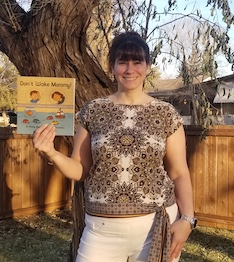
By MYRON LOVE Avra Love’s first children’s book has just been released. “Don’t Wake Mommy! A Story About Honouring Parents” is part of a three-book deal that Avra signed with James Gershfield, the president of New Jersey-based Scribal Scion Publishing. The book focuses on Aaron, a Jewish little boy who loves his parents dearly and is always trying to please them.
In “Don’t Wake Mommy!”, Aaron is trying to be considerate of his mommy, who is trying to get some sleep. So, when he discovers water leaking in the basement, he tries to deal with the problem himself – without having to wake his mother – with predictable results.
“Don’t Wake Mommy!” is Avra’s second published book. She published her first, a book of short stories called “Into the Junk Drawer and Other Stories” on Amazon in the spring of 2022. The book sold well – around 250 copies and received very positive comments from many of its readers.
“I have been writing for as long as i can remember,” she comments. “Over the years, I have dabbled in prose and poetry, short stories and longer pieces.”
She began writing the stories that make up “Into the Junk Drawer” shortly after giving birth to her son, Ares, in late 2021. The book consists of a collection of 35 stories – each two to three pages long and each with a moral or a twist at the end.
She became aware of James Gershfield in the summer of 2024 after I wrote a couple of stories about him in the Jewish Post about biographies he had written about his parents, former Winnipeggers Rabbi Edward and Toby Gershfield. His mother was a granddaughter of the late revered Rabbi Israel Kahanovitch.
James Gershfield published both books through Scribal Scion Publishing, which he founded two years after retiring from a 40-year career as a software developer. Scribal Scion Publishing focuses on Jewish books that inspire and comfort. Genres include memoir, biography, religion, and comfort for mourners, as well as children’s books.
In a comment to Avra, Gershfield wrote that “I think you have a great talent for coming up with fun stories for kids – stories that also teach some valuable lessons”.
Avra reports that she wrote the draft of “Don’t Wake Mommy!” several years ago. “Working with James, I learned a lot about the unique features of writing children’s stories. While the process (of publishing) took longer than I expected, I am very happy with the final result.”
She notes that the second book in the series – “Taking Care of Mommy” – should be out next year and the third ,‘”Aaron’s Buried Treasure” – the year after that. In the meantime, she has another group of short stories almost ready for publication and is working on a Chanukah craft fair murder mystery.
“Don’t Wake Mommy!” is available online at Amazon or you can call 204 334-4961 to get your copy.
Local News
Lifelong friend of Israel and the Jewish people John Plantz is the epitome of humility
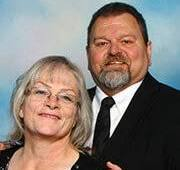
By MYRON LOVE In the Torah, the prophet Micah, asks the question: “O man. What does the Lord require of you?” to which the Lord responds: “to act justly and to love mercy and to walk humbly with your God.”
John Plantz tries to live those precepts every day. Though recently retired as the Christian Friends of Israel’s director, the lifelong supporter of Israel and our local Jewish community has been and remains actively involved as a volunteer in several of our institutions, among them Canadian Magen David Adom, Friends of JNF Canada, Canadian Associates of Ben-Gurion University of the Negev, Canadian Friends of Haifa University, Leket Canada, Operation Lifeshield, and the Jewish Foundation of Manitoba. (He and his wife, Irene, were Endowment Book of life singers a few years back.)
I first met John Plantz more than 25 years ago when I joined the board of the old Jewish Public Library; he was the volunteer librarian back then – and he told me his story.
His first encounters with Jews came while he was growing up near the former Jewish farm colony at Camper – about a two hour drive northwest of Winnipeg. “It was one of the Baron Hirsch farm colonies,” he recalled. (Hirsch started several Jewish farm colonies in Western Canada and Argentina in the late 19th and early 20th centuries.) When I was a kid, there were still a lot of Jewish families in the area.”
Post high school Plantz found himself adrift – unsure of what he wanted to do with his life. He worked in construction for a time, tried joining the RCMP (but they weren’t taking on any new recruits at that time) – and contemplated going to university. He also thought about playing professional baseball.
Then he heard about an evangelical bible school – Briercrest College and Seminary – in west central Saskatchewan, and applied for admission. He says that he was initially attracted to the institution because of its sports program. However, he also found himself becoming increasingly interested in the Bible and became a devout Christian. His experience at Briercrest further fostered his passion for Israel.
In 1979, he graduated with a Bachelor of Religious Education and a teaching certificate. In 1983, John married Irene Plett. He recalls that, at the reception, he suddenly leaned over to his new bride and said, “One day, I’m going to Israel.”
From 1978 to1988, he worked as a youth pastor and as a “circuit preacher” in northern Manitoba and Saskatchewan. In 1989 he decided to go back to school, to attend Briercrest Seminary to obtain his Masters of Ministry with studies in archaeology in Israel.
“As I studied the Bible more intently,” he recalls, “one of my professors suggested that if I really wanted to understand the Bible better, I should hear it taught from a Jewish perspective.”
To that end, in 1991, he began attending the Beth Jacob Synagogue in Regina. He went to Shabbat services regularly for a year and became friendly with the rabbi. One day, after Shabbat service, the Rabbi asked him if he was Jewish because he had a Jewish friend with the same last name.
“My plans to visit Israel were already in the works,” he says, “and so I tucked this away as something I should pursue while there.”
In Israel that first time – the first of many visits to Israel – 28 at last count – he took archaeology courses at the Hebrew University and went on some digs. He also looked into his surname and found that it was a Hungarian Jewish name.
When he returned to Canada, he asked his grandfather, Ralph Plantz, whether he was, in fact, Jewish, his grandfather acknowledged that he did have Jewish ancestry. When John asked why his grandfather had never mentioned it before, the response was that no one asked.
“My ‘zaida’ (which is how John now refers to his late grandfather) always encouraged us to treat Jewish people with respect,” John notes.
While still a devoted Christian, he says that he does consider himself Jewish.
After coming back from Israel that first time John began volunteering with Christian Friends of Israel. He also began volunteering at the old Jewish Public Library.
“I loved being at the library,” he reminisces. “I had studied both Hebrew and Yiddish so I could work comfortably with the collection.”
He speaks fondly about some of the regulars who visited the library. “I learned a lot from them,” he says.
He remembers the late Noach Witman in particular. “Noach was one of the kindest men I have ever known,” he says.
(Witman was the founder and long time host of the Jewish radio hour Sunday afternoons – which is still on the air every Sunday from 1:30 to 2:30 on CHJS radio 810 on the am dial.)
During that time, Plantz began to attend north Winnipeg synagogues on Shabbat and volunteer for a number of Winnipeg-based Israel fundraising organizations.
In 2018, he assumed the role of Manitoba Director of Christian Friends of Israel, a position he just retired from at the end of August. He declares however, that he will continue to work on behalf of Israel and the Jewish people as long as he is able.
He is proud to report that his seven children all share his and Irene’s passion for the Children of Israel and all helped out at the Jewish Public Library. “All five of my sons took Yiddish lessons and one of my daughters studied Hebrew,” he says.
Plantz quotes the Prophet Jeremiah as declaring that – to paraphrase – as long as the sun, the moon and the stars are in the sky, “the seed of Israel shall not cease from being a nation before me”.
“And so must be our love for the Jewish People and Israel,” Plantz concludes.


